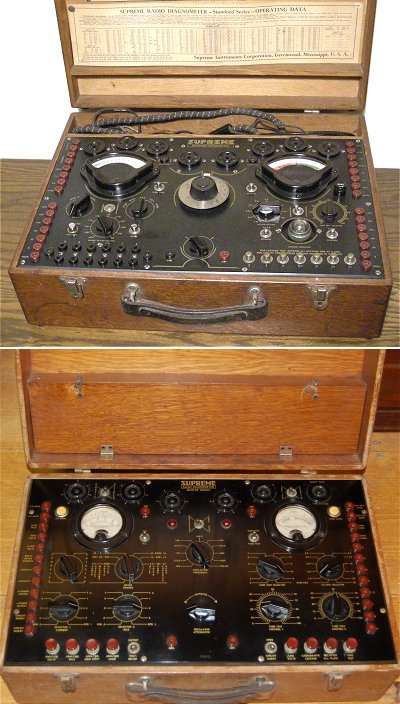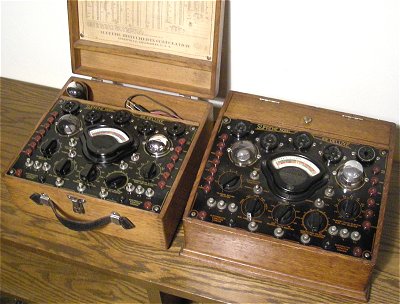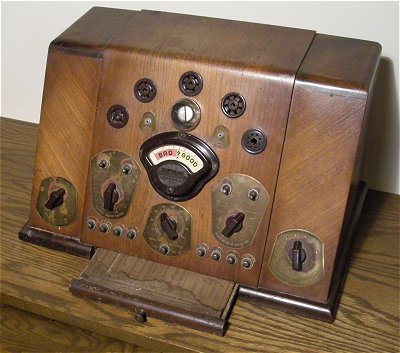BY STEVE JOHNSON ()
Supreme Instruments was a major manufacturer of test equipment for 30 years from the mid 1920s to the 1950s. Their test equipment was not only functional, but stood out from most other brands in both quality construction and looks. Supreme designed and produced many of the radio analyzers, multimeters, panel meters, and tube testers used by repair shops and radio/TV servicemen from the 1920s into the 1950s.

Early Supreme Counter Card
Supreme was founded by Jewel R. Williams in 1926 in Greenwood, MS. Supreme's first location was a small garage not unlike Hickok Electrical Instruments and Hewlett Packard's first locations. From the beginning, Williams felt that with the tremendous volume of radio distribution at that time and its probable continued expansion, there was not only room for an organization dealing exclusively with servicing, but that an organization for this purpose was absolutely essential to the maximum development of radio. It's also interesting to note that founder Williams was cousin to Harry Williams, who started the Williams Manufacturing Company in the 1940s that manufactured one of the most popular lines of pinball machines.
There were several companies producing test equipment for the new radio service industry. What set Supreme apart was a belief that test equipment should not only be functional, it should also be impressive to look at. A customer should see that the shop and serviceman used the latest test equipment for servicing their radio. Supreme emphasized to shops the importance of having the service bench in full view of the customers to set their minds at ease that the service bench was equipped with professional service equipment and their radio was in good hands.

An early Supreme “Pocket Watch” battery tester.
One of Supreme's first products was a handheld meter for testing radio batteries in the home. Since most homes did not have electricity in the 1920s, radios were battery powered. A meter was needed to check the charge left in the batteries so the radio would not die halfway through a favorite evening radio broadcast. These home meters were about the size and shape of a pocket watch. Today many makes and styles of these pocket watch meters may be found for between $10 and $25.
By 1930 Supreme was focused exclusively on manufacturing test equipment for the serviceman and his workbench. Supreme's equipment was designed not only for function, but also as a piece of art that would impress the customer.

The Supreme 535 oscilloscope and 581 signal generator.
Many of Supreme's 1930s bench models were designed with beautiful etched brass front panels. The model 535 oscilloscope and 581 Signal Generator pictured above are among my favorites in Supreme's mid 1930s line. The early oscilloscope is popular among collectors and sells for upwards of $400 in good condition. The signal generator my be found at times for under $70, but expect to pay much more for one in excellent cosmetic condition.

Supreme's Standard (top) and Master (bottom) Diagnometers.
Supreme was famous for combining all testers a serviceman would need when making house calls into one large tester. The company referred to its line of all-in-one testers as “Diagnometers,” which was short for “Diagnosis By Meter.” Supreme built several Diagnometers over the years. Supreme's early Diagnometers were housed in a portable tool case along with space for tools, adapters, and spare tubes. Their later Diagnometers were huge by today's standards and even though they came equipped with a handle they were more at home on a service bench than being carried up a flight of stairs on a service call. Early models of Supreme's Diagnometers are fairly rare, but may be found for $100 to $300. The later models, such as the 585 series, usually sell for less than $150 in good condition.

Portable and bench tube testers were Supreme's most popular product.
By far the most popular product ever produced by Supreme Instruments was the vacuum tube tester. You will often see several at any time on auction sites. Their model 85 and 89 tube tester lines were available in both a portable oak case and slanted bench top versions for use in the shop. Around 1934 Supreme switched production of the 85 from a typical round meter to a new fan shaped meter.

Supreme's 89C was intended to sit on a counter and allow the customer to test their own tubes.
Due to the large amount sold and the artful styling of the face, many have survived today. Although not very useful today as they do not test later, popular tubes, these are probably one of the most popular display pieces in many collections. Prices on the portable 85 and 89 range from $50 to over $100. If you find an 85C or 89C counter top version intended for customer use, the price can easily top $400 to $500, as these are very rare and seldom seen.
With the start of World War II, Supreme opened a second factory in Greenwood and manufactured military tube testers, multimeters, and panel meters. At one point, Supreme was producing over 1,500 meters a day for the war effort.
After the war, Supreme produced television test equipment along with their already popular lines of meters and tube testers. By then competition was fierce and there were many companies manufacturing test equipment. In 1956, Supreme Instruments was purchased by Hickok and the facilities in Greenwood became known as Hickok-Supreme. Today Hickok-Waekon manufactures test equipment for the auto repair industry in the original and expanded Hickok-Supreme facility.
For more information and examples of Supreme Instruments visit SupremeInstruments.org.
For more information and examples of early electronic technology view my collection at StevesAntiqueTechnology.com.
Advertisement





